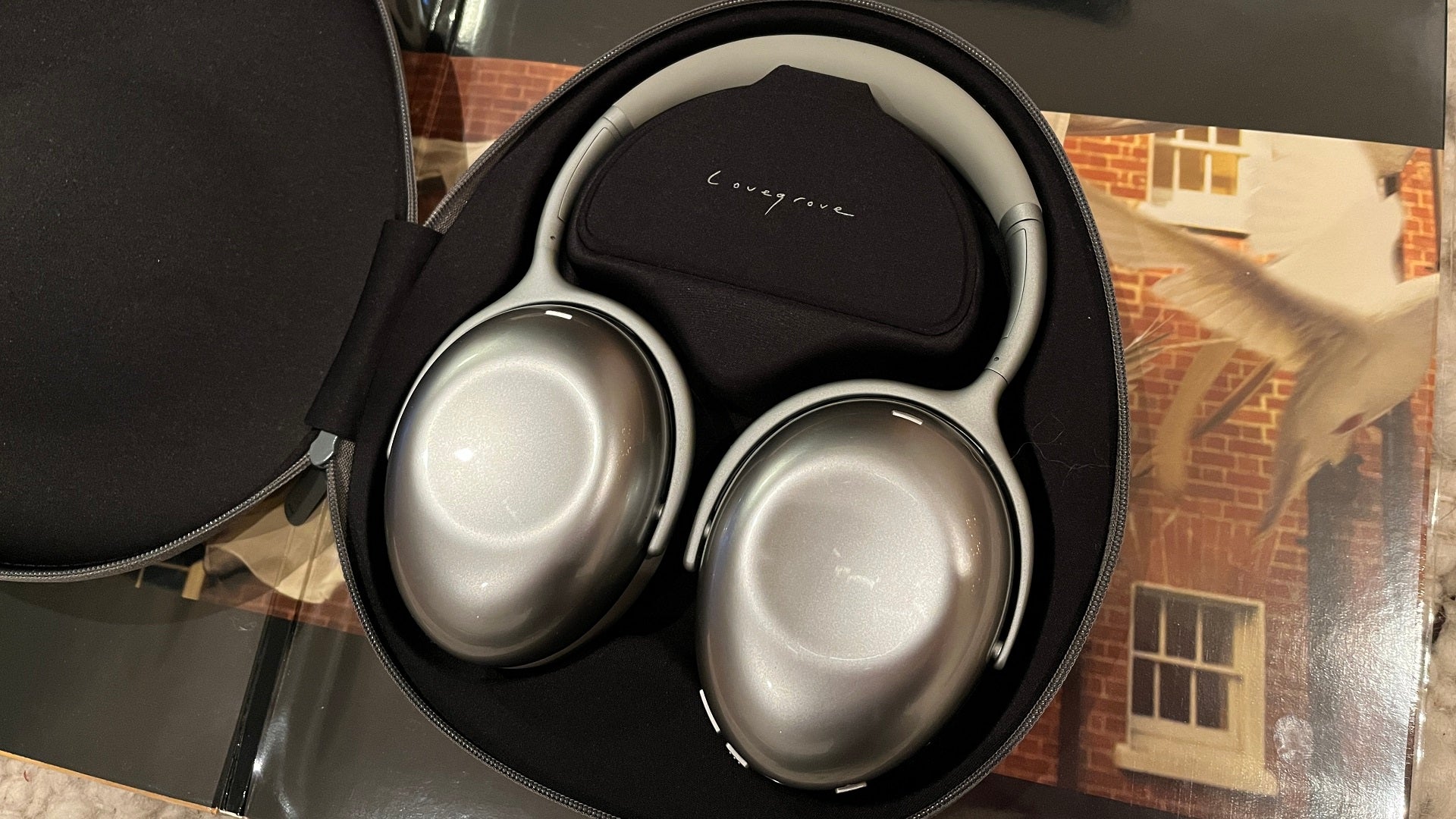KEF has got plenty right with the Mu7, not least the high-end sheen of their sound and the mildly individual looks. But this section of the market is so cut-throat that plenty isn’t quite enough.
Pros
- Revealing, full-scale and high-gloss sound
- Good technical specification and proper battery life
- Some ‘designing’ has gone on
Cons
- No fans of cheaper or coarser recordings
- A control app and/or some voice control would be nice
- ANC makes its presence felt
-
Wireless specsBluetooth 5.1 with SBC, AAC, aptX and aptX HD compatibility -
Battery life40-hours of battery life -
Audio40mm full-range dynamic drivers
Introduction
Given how many companies want to sell you some wireless active noise-cancelling over-ear headphones, it seems almost negligent of KEF to have left it until now.
The British specialist has lately been making waves with its powered streaming-system-in-a-pair-of-speakers models in particular – but obviously the land-grab isn’t over and finally KEF is ready to nick a piece of the action.
Well, at least that’s the theory. The price and the broad specification of the Mu7 lines them up against some proven, successful and deeply covetable rivals… so how exactly does KEF intend to muscle into the market?
Availability
- UKRRP: £349
- USARRP: $399
- EuropeRRP: €399
- CanadaRRP: CA$599
- AustraliaRRP: AU$535
The KEF Mu7 are on sale now, and they go for £349 in the United Kingdom. That translates to $399 in the United States and around AU$539 in Australia.
Design
- Another KEF/Ross Lovegrove collaboration
- A choice of two finishes
- Limited control options
Just a few seconds in the company of your search engine of choice will reveal an absolute stack of similarly priced, broadly similarly specified alternatives from a whole host of companies, from household names like Sony to headphone specialists like Sennheiser via KEF-alike brands like Bowers & Wilkins. Which means the Mu7 will need to be something special if they’re not going to get lost in the pack.
If you know much about KEF, you’ll know the company’s a big fan of the designer Ross Lovegrove. So not for the first time, he’s brought his mildly organic, curvaceously slippery style to bear here – or, at least, as much as is possible when you’re talking about a product as necessarily functional as over-ear headphones.
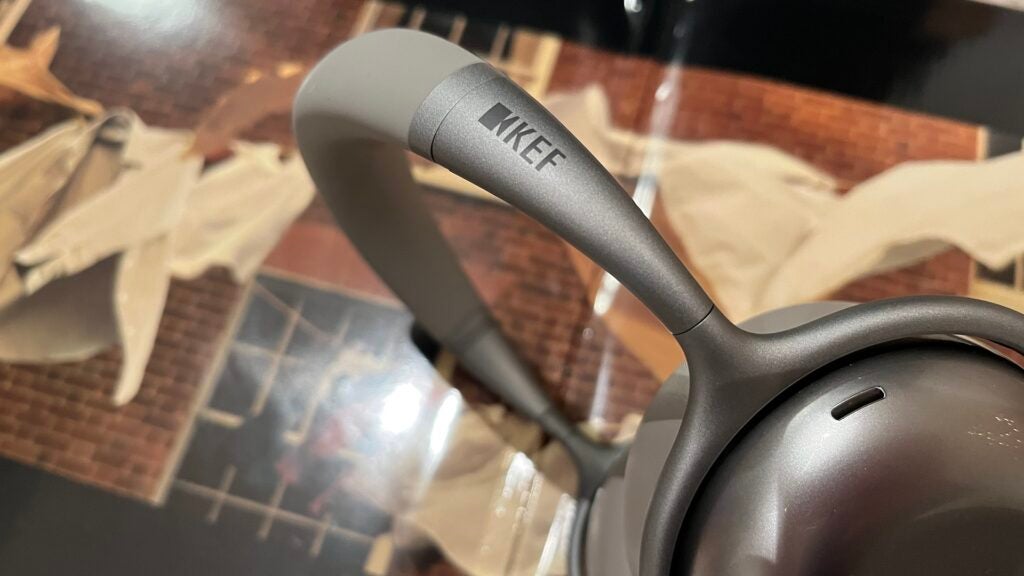
For the most part, the Mu7 are premium wireless over-ear headphone business as usual. The slender arms and yokes are of smooth, expertly fitted aluminium, while the earpads and the central portion of the headband are breathable leatherette – the earpads are filled with memory foam.
It’s really only the earcups that bear any sign of having been designed – they too are of smooth aluminium, with a sizable indent or recess on the upper part letting you know Mr Lovegrove has been earning his corn. The Mu7 weigh a middling 309g, but they wear it well – it’ll be a mightily long listening session before they become in any way uncomfortable. Even the earpads resist handing back your own body heat for a little longer than is the norm.
The Mu7 are available in silver grey (silver) or charcoal grey (black). Each earcup has slot-shaped mic openings at the top of the earcups – the mics take care of active noise-cancellation and telephony, with the assistance of a further mic-hole towards the bottom of the right earcup.
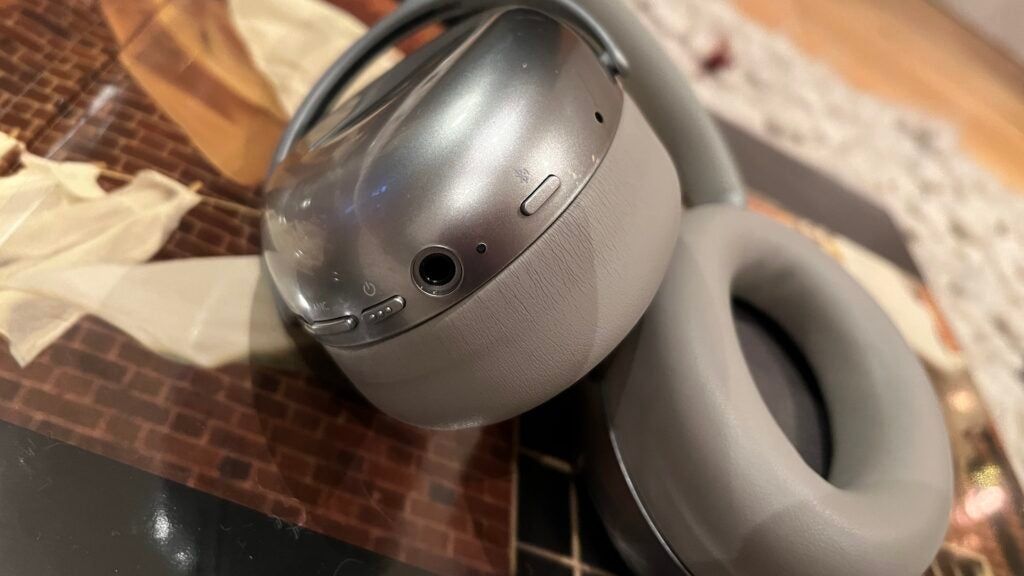
It’s the right earcup that does all the leg-work, in fact. Here’s where you’ll find a USB-C socket, a 3.5mm analogue input, and buttons to cycle through your three ANC options, to turn power on or off, and to initiate Bluetooth pairing. KEF provides quite swish USB-A-to-USB-C and 3.5mm-3.5mm cables, along with a flight adapter, in the headphones’ semi-hard carry-case. The Mu7 fold flat, but not in on themselves, to facilitate (slightly) easier transport.
The recess on the right earcup is also a capacitive touch-surface. It’s a reliable and responsive interface, and allows you to adjust volume, skip forwards or backwards, or pause playback. A long press on the ANC button defeats or enables the touch-surface itself.
Features
- 40 hours battery life
- 40mm full-range drivers
- Bluetooth 5.1 with SBC, AAC and aptX HD
Thanks to aptX HD codec compatibility and Bluetooth 5.1 wireless connectivity, the KEF Mu7 are capable of streaming at an authentically high-resolution 24-bit/48kHz standard. And if you choose to hard-wire them to a source of music, then naturally even higher-resolution playback is possible.
Unlike a number of rivals, the Mu7 don’t have to be powered up to be listened to using wires – although you’ll need to switch them on if you want to use active noise-cancellation at the same time, of course.
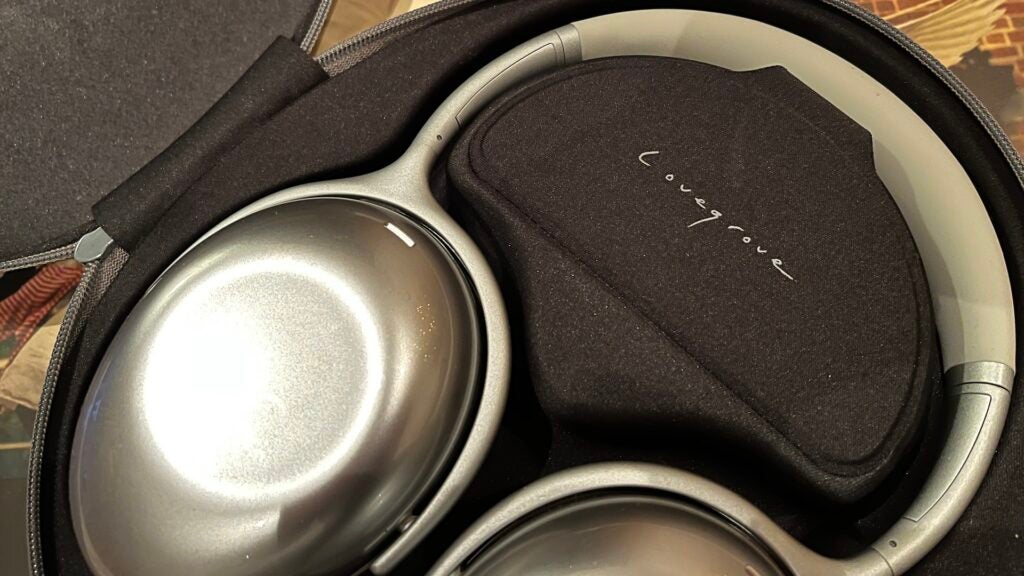
However you choose to get it there, once the audio information is on board your Mu7 it’s delivered to your ears by a pair of 40mm full-range dynamic drivers. A frequency response such as KEF is claiming, of 20Hz – 20kHz, is both ample and eminently achievable.
Powering the headphones is an 100mAh lithium-ion battery that’s good for 40 hours of playback between charges – and that’s when operating wirelessly and with ANC switched on. Plug the Mu7 into the mains via their USB-C socket for just 15 minutes and another eight hours or so of playback can be yours.
Those three active noise-cancellation modes I referred to consist of off, on and Smart on. This last setting seeks to assess your ambient environment in real time, and trim the ANC accordingly – KEF suggests specific areas of the frequency range can be targeted in response to the information the Mu7 pick up. The headphones appraise your environment using their embedded mics, of course – and KEF has specified cVc (clear voice capture) technology in a drive for optimum call quality.
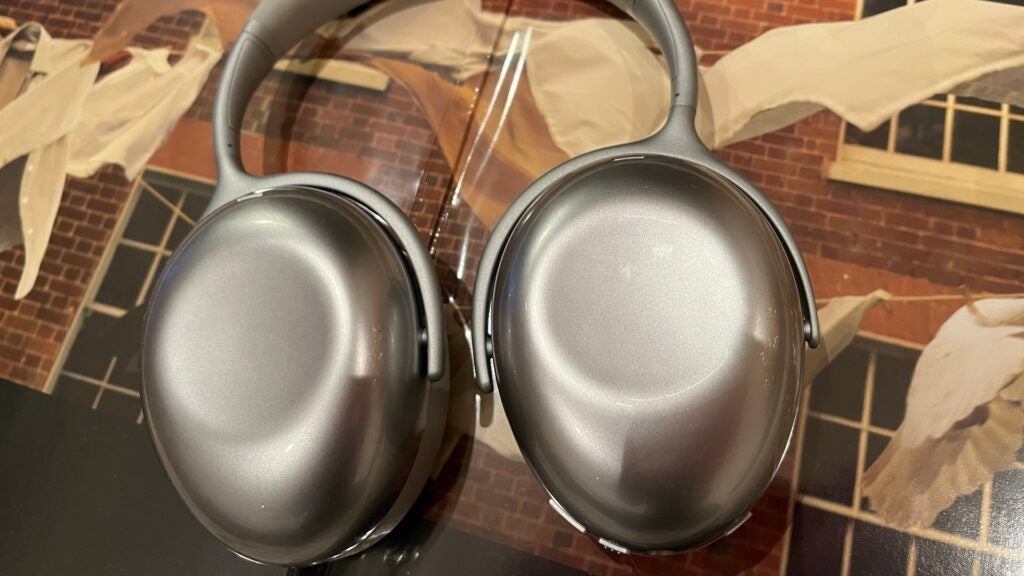
So far, it’s a feature-set that’s entirely appropriate for a product of this type and cost – but there are a couple of blanks on the KEF’s spec-sheet. Unlike almost every price-comparable rival (and quite a few that are fair bit more affordable, too), there’s no control app accompanying the Mu7. This means no adjustable EQs, no sliding scale of ANC, no firmware upgrades or any of the other stuff I’ve come to expect where wireless headphones of all types are concerned.
And there’s no voice-control available, either – which is perhaps not as big an omission as the lack of app control, but nevertheless leaves a box unticked that you might expect your £349 outlay to have ticked in big fat magic marker.
Sound Quality
- Big, informative and overtly good taste sound
- Well-organised and convincing soundstage
- Faint-but-definite ANC issues
It’s difficult to know for sure, of course, but if the words good taste and grown-up weren’t as high on the list of Mu7 sonic requirements as detailed and high-fidelity then I’ll eat my metaphorical hat.
Of course, there’s a bit more to these KEF than a high-sheen, smooth and rather self-consciously mature presentation. Five minutes in the company of a TIDAL-derived stream of Cornflake Girl by Tori Amos allows the Mu7 to explain a lot of what they’re all about – and a lot is a lot of what they’ve got.
The soundstage they create is big, convincingly laid out and absolutely rock-solid in its focus and separation. Despite the agreeable amount of space each strand of the recording enjoys, though, the KEF unify every element into a coherent whole and present the entire thing as a single entity. Even the densest mixes or most complex recordings are fairly easy to follow as a result.
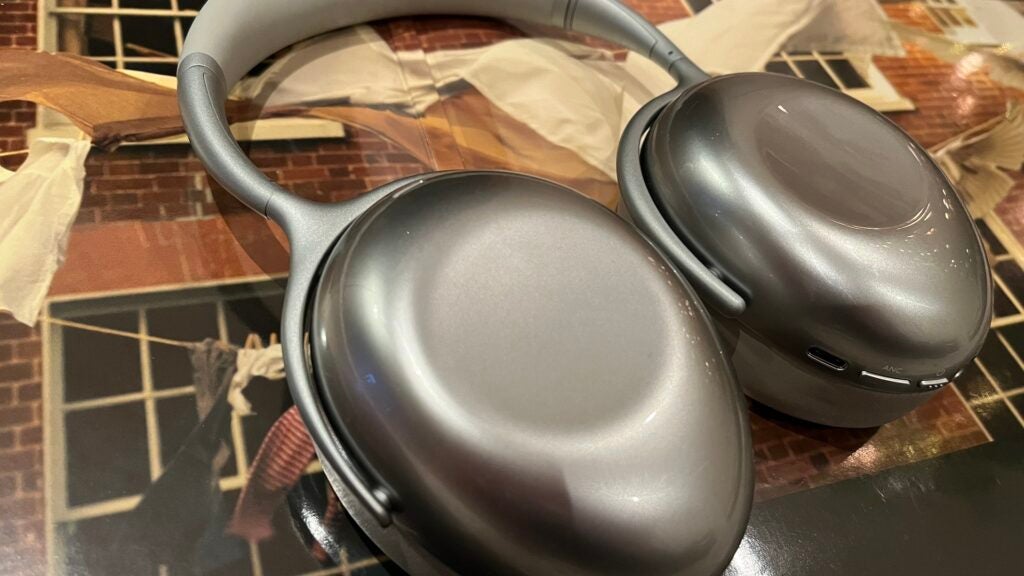
The outright scale of sound they’re able to produce is impressive too – but detail levels are always high, even in the midst of a hectic or multi-faceted recording. Harmonic variations are made apparent, a singer’s technique is made plain, and everything from the broad strokes at the front of the stage to the most fleeting, transient events at the back of it is given appropriate emphasis and weight. The Mu7 don’t sound academic or dispassionate, though – they simply seem very attentive. Tonality is natural enough, too.
There’s not a whole lot of weight or purpose about the low frequencies the KEF generate, though. For all that they respond all the way to 20Hz, there’s not a whole lot of substance to the bass here – and their powder-puff lack of body rather undermines the straight-edged control the headphones demonstrate. It follows that rhythmic certainty is rather, well, uncertain – and music that relies on momentum and drive can sound ineffectual.
Consider an equally obvious lack of outright dynamic headroom at the same time, and it becomes apparent the KEF Mu7 are far from the most assertive or demonstrative headphones around when it comes to the more visceral aspects of music-making. Their stance is welcome when listening to Fleetwood Mac’s Songbird, for sure, but it’s a hindrance if you switch to something as deranged as Melt Banana’s Candy Gun. The Mu7 are overly concerned with not giving offence – which, when the music you’re listening to seeks to be as offensive as possible, is no help whatsoever.
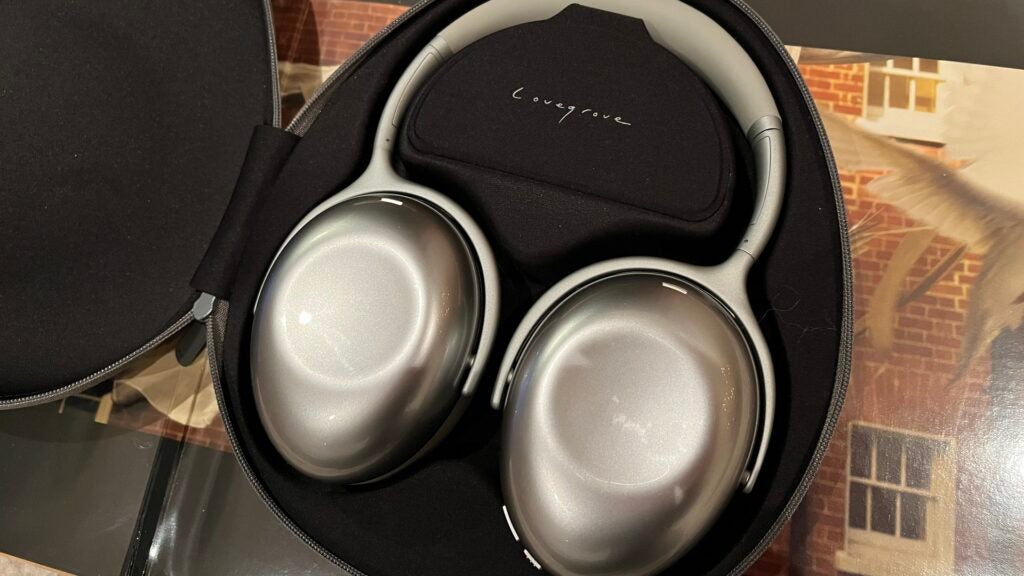
Of course, this sort of sonic attitude will be absolutely fine for those listeners who aren’t interested in this sort of shouty, pimply nonsense in the first place. But there are enough price-comparable rivals around to make the KEF sound slightly one-paced and less than adaptable.
Oddly enough, the Mu7 manages to combine similar traits when it comes to the way they deal with external sounds. Switch ANC on or (Smart on if you’re out and about) and there’s no two ways about it: they do a very decent job on all ambient noise short of ear-splitting.
But unlike almost all credible alternatives, they alter their audio stance a little when ANC is switched on – the top of the frequency range seems to diminish and round off just a little. And more significantly, switching on ANC introduces just a tiny hint of counter-signal, an almost cabin pressure sensation of the type I thought I’d heard the last of.
Latest deals
Should you buy it?
You enjoy a high-end, high-gloss sound When the KEF Mu7 are enjoying the music you’re listening to, they’re as enjoyable a listen as any price-comparable rival
Your music tastes are wide-ranging The Mu7 have a definite comfort-zone – and taking them out of it is unlikely to end well
Final Thoughts
As the star-rating suggests, the KEF Mu7 need to be better if they’re going to appeal to as wide an audience as possible. That they’ll find their constituency is undeniable – no pair of headphones that’s as sweetly detailed, as tonally correct and sounds as out-and-out glossy as these KEFs can fail to do so. But there’s more to life than hi-fi sound, just as there’s more to life than fine dining – and who doesn’t enjoy a take-away every now and then?
How we test
We test every set of headphones we review thoroughly over an extended period of time. We use industry standard tests to compare features properly. We’ll always tell you what we find. We never, ever, accept money to review a product.
Find out more about how we test in our ethics policy.
Tested for more than a week
Tested with real world use
FAQs
The Mu7 don’t have to be powered on to enable noise-cancellation, so ANC can be used when plugged into a wired source without turning the headphones on.
Jargon buster
ANC
ANC (Active Noise Cancellation) uses an array of microphones in a headphone to detect the frequency of the sound coming at the listener, with the ANC chip creating an inverse wave (i.e. opposing sound) to suppress any unwanted external noises.
Bluetooth
Bluetooth – named after 10th-century Danish king Harald Bluetooth who united Denmark’s tribes into a single kingdom – is a method of wireless transmission that allows for the exchange of data between devices over short distances.
KEF has got plenty right with the Mu7, not least the high-end sheen of their sound and the mildly individual looks. But this section of the market is so cut-throat that plenty isn’t quite enough.
Pros
- Revealing, full-scale and high-gloss sound
- Good technical specification and proper battery life
- Some ‘designing’ has gone on
Cons
- No fans of cheaper or coarser recordings
- A control app and/or some voice control would be nice
- ANC makes its presence felt
-
Wireless specsBluetooth 5.1 with SBC, AAC, aptX and aptX HD compatibility -
Battery life40-hours of battery life -
Audio40mm full-range dynamic drivers
Introduction
Given how many companies want to sell you some wireless active noise-cancelling over-ear headphones, it seems almost negligent of KEF to have left it until now.
The British specialist has lately been making waves with its powered streaming-system-in-a-pair-of-speakers models in particular – but obviously the land-grab isn’t over and finally KEF is ready to nick a piece of the action.
Well, at least that’s the theory. The price and the broad specification of the Mu7 lines them up against some proven, successful and deeply covetable rivals… so how exactly does KEF intend to muscle into the market?
Availability
- UKRRP: £349
- USARRP: $399
- EuropeRRP: €399
- CanadaRRP: CA$599
- AustraliaRRP: AU$535
The KEF Mu7 are on sale now, and they go for £349 in the United Kingdom. That translates to $399 in the United States and around AU$539 in Australia.
Design
- Another KEF/Ross Lovegrove collaboration
- A choice of two finishes
- Limited control options
Just a few seconds in the company of your search engine of choice will reveal an absolute stack of similarly priced, broadly similarly specified alternatives from a whole host of companies, from household names like Sony to headphone specialists like Sennheiser via KEF-alike brands like Bowers & Wilkins. Which means the Mu7 will need to be something special if they’re not going to get lost in the pack.
If you know much about KEF, you’ll know the company’s a big fan of the designer Ross Lovegrove. So not for the first time, he’s brought his mildly organic, curvaceously slippery style to bear here – or, at least, as much as is possible when you’re talking about a product as necessarily functional as over-ear headphones.

For the most part, the Mu7 are premium wireless over-ear headphone business as usual. The slender arms and yokes are of smooth, expertly fitted aluminium, while the earpads and the central portion of the headband are breathable leatherette – the earpads are filled with memory foam.
It’s really only the earcups that bear any sign of having been designed – they too are of smooth aluminium, with a sizable indent or recess on the upper part letting you know Mr Lovegrove has been earning his corn. The Mu7 weigh a middling 309g, but they wear it well – it’ll be a mightily long listening session before they become in any way uncomfortable. Even the earpads resist handing back your own body heat for a little longer than is the norm.
The Mu7 are available in silver grey (silver) or charcoal grey (black). Each earcup has slot-shaped mic openings at the top of the earcups – the mics take care of active noise-cancellation and telephony, with the assistance of a further mic-hole towards the bottom of the right earcup.

It’s the right earcup that does all the leg-work, in fact. Here’s where you’ll find a USB-C socket, a 3.5mm analogue input, and buttons to cycle through your three ANC options, to turn power on or off, and to initiate Bluetooth pairing. KEF provides quite swish USB-A-to-USB-C and 3.5mm-3.5mm cables, along with a flight adapter, in the headphones’ semi-hard carry-case. The Mu7 fold flat, but not in on themselves, to facilitate (slightly) easier transport.
The recess on the right earcup is also a capacitive touch-surface. It’s a reliable and responsive interface, and allows you to adjust volume, skip forwards or backwards, or pause playback. A long press on the ANC button defeats or enables the touch-surface itself.
Features
- 40 hours battery life
- 40mm full-range drivers
- Bluetooth 5.1 with SBC, AAC and aptX HD
Thanks to aptX HD codec compatibility and Bluetooth 5.1 wireless connectivity, the KEF Mu7 are capable of streaming at an authentically high-resolution 24-bit/48kHz standard. And if you choose to hard-wire them to a source of music, then naturally even higher-resolution playback is possible.
Unlike a number of rivals, the Mu7 don’t have to be powered up to be listened to using wires – although you’ll need to switch them on if you want to use active noise-cancellation at the same time, of course.

However you choose to get it there, once the audio information is on board your Mu7 it’s delivered to your ears by a pair of 40mm full-range dynamic drivers. A frequency response such as KEF is claiming, of 20Hz – 20kHz, is both ample and eminently achievable.
Powering the headphones is an 100mAh lithium-ion battery that’s good for 40 hours of playback between charges – and that’s when operating wirelessly and with ANC switched on. Plug the Mu7 into the mains via their USB-C socket for just 15 minutes and another eight hours or so of playback can be yours.
Those three active noise-cancellation modes I referred to consist of off, on and Smart on. This last setting seeks to assess your ambient environment in real time, and trim the ANC accordingly – KEF suggests specific areas of the frequency range can be targeted in response to the information the Mu7 pick up. The headphones appraise your environment using their embedded mics, of course – and KEF has specified cVc (clear voice capture) technology in a drive for optimum call quality.

So far, it’s a feature-set that’s entirely appropriate for a product of this type and cost – but there are a couple of blanks on the KEF’s spec-sheet. Unlike almost every price-comparable rival (and quite a few that are fair bit more affordable, too), there’s no control app accompanying the Mu7. This means no adjustable EQs, no sliding scale of ANC, no firmware upgrades or any of the other stuff I’ve come to expect where wireless headphones of all types are concerned.
And there’s no voice-control available, either – which is perhaps not as big an omission as the lack of app control, but nevertheless leaves a box unticked that you might expect your £349 outlay to have ticked in big fat magic marker.
Sound Quality
- Big, informative and overtly good taste sound
- Well-organised and convincing soundstage
- Faint-but-definite ANC issues
It’s difficult to know for sure, of course, but if the words good taste and grown-up weren’t as high on the list of Mu7 sonic requirements as detailed and high-fidelity then I’ll eat my metaphorical hat.
Of course, there’s a bit more to these KEF than a high-sheen, smooth and rather self-consciously mature presentation. Five minutes in the company of a TIDAL-derived stream of Cornflake Girl by Tori Amos allows the Mu7 to explain a lot of what they’re all about – and a lot is a lot of what they’ve got.
The soundstage they create is big, convincingly laid out and absolutely rock-solid in its focus and separation. Despite the agreeable amount of space each strand of the recording enjoys, though, the KEF unify every element into a coherent whole and present the entire thing as a single entity. Even the densest mixes or most complex recordings are fairly easy to follow as a result.

The outright scale of sound they’re able to produce is impressive too – but detail levels are always high, even in the midst of a hectic or multi-faceted recording. Harmonic variations are made apparent, a singer’s technique is made plain, and everything from the broad strokes at the front of the stage to the most fleeting, transient events at the back of it is given appropriate emphasis and weight. The Mu7 don’t sound academic or dispassionate, though – they simply seem very attentive. Tonality is natural enough, too.
There’s not a whole lot of weight or purpose about the low frequencies the KEF generate, though. For all that they respond all the way to 20Hz, there’s not a whole lot of substance to the bass here – and their powder-puff lack of body rather undermines the straight-edged control the headphones demonstrate. It follows that rhythmic certainty is rather, well, uncertain – and music that relies on momentum and drive can sound ineffectual.
Consider an equally obvious lack of outright dynamic headroom at the same time, and it becomes apparent the KEF Mu7 are far from the most assertive or demonstrative headphones around when it comes to the more visceral aspects of music-making. Their stance is welcome when listening to Fleetwood Mac’s Songbird, for sure, but it’s a hindrance if you switch to something as deranged as Melt Banana’s Candy Gun. The Mu7 are overly concerned with not giving offence – which, when the music you’re listening to seeks to be as offensive as possible, is no help whatsoever.

Of course, this sort of sonic attitude will be absolutely fine for those listeners who aren’t interested in this sort of shouty, pimply nonsense in the first place. But there are enough price-comparable rivals around to make the KEF sound slightly one-paced and less than adaptable.
Oddly enough, the Mu7 manages to combine similar traits when it comes to the way they deal with external sounds. Switch ANC on or (Smart on if you’re out and about) and there’s no two ways about it: they do a very decent job on all ambient noise short of ear-splitting.
But unlike almost all credible alternatives, they alter their audio stance a little when ANC is switched on – the top of the frequency range seems to diminish and round off just a little. And more significantly, switching on ANC introduces just a tiny hint of counter-signal, an almost cabin pressure sensation of the type I thought I’d heard the last of.
Latest deals
Should you buy it?
You enjoy a high-end, high-gloss sound When the KEF Mu7 are enjoying the music you’re listening to, they’re as enjoyable a listen as any price-comparable rival
Your music tastes are wide-ranging The Mu7 have a definite comfort-zone – and taking them out of it is unlikely to end well
Final Thoughts
As the star-rating suggests, the KEF Mu7 need to be better if they’re going to appeal to as wide an audience as possible. That they’ll find their constituency is undeniable – no pair of headphones that’s as sweetly detailed, as tonally correct and sounds as out-and-out glossy as these KEFs can fail to do so. But there’s more to life than hi-fi sound, just as there’s more to life than fine dining – and who doesn’t enjoy a take-away every now and then?
How we test
We test every set of headphones we review thoroughly over an extended period of time. We use industry standard tests to compare features properly. We’ll always tell you what we find. We never, ever, accept money to review a product.
Find out more about how we test in our ethics policy.
Tested for more than a week
Tested with real world use
FAQs
The Mu7 don’t have to be powered on to enable noise-cancellation, so ANC can be used when plugged into a wired source without turning the headphones on.
Jargon buster
ANC
ANC (Active Noise Cancellation) uses an array of microphones in a headphone to detect the frequency of the sound coming at the listener, with the ANC chip creating an inverse wave (i.e. opposing sound) to suppress any unwanted external noises.
Bluetooth
Bluetooth – named after 10th-century Danish king Harald Bluetooth who united Denmark’s tribes into a single kingdom – is a method of wireless transmission that allows for the exchange of data between devices over short distances.


















